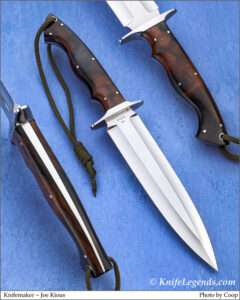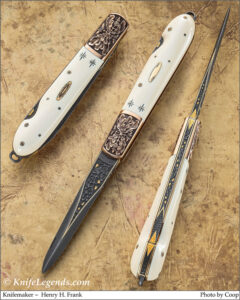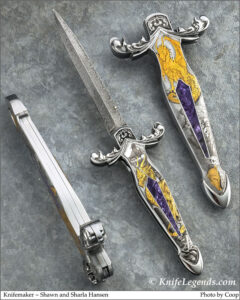For collectors and investors, vintage knives present a unique opportunity. Beyond their practical function, these knives are often works of art, reflecting master craftsmanship and historical significance. Investing in vintage knives not only allows you to enjoy beautiful, functional pieces, but it can also yield long-term financial benefits as certain knives increase in value over time. However, like any investment, it’s crucial to approach the process with knowledge and careful consideration. This guide will walk beginners through essential aspects of investing in vintage knives, with a focus on purchasing from a custom knife dealer.
In order to make sure we are all thinking of the same thing when we discuss Vintage Knives it’s essential to define a few important terms.
Generally speaking, an art knife that is not more than 25 years old is considered Contemporary.
An art knife that is between 25 and 50 years old would be considered Vintage.
An Art Knife between 50 and 75 years old would be considered Semi-antique and an art knife older than 75 years would be considered Antique.
Why Invest in Vintage Knives?
Vintage knives are more than just tools; they are artifacts that capture the essence of different eras and craftsmanship styles. Whether you’re interested in historical blades from World War I, limited-edition models from renowned makers, or custom creations, the market offers a wide variety of choices. Some reasons collectors invest in vintage knives include:
- Historical Significance: Many vintage knives have ties to significant historical events or periods, making them sought-after pieces for both collectors and history enthusiasts.
- Craftsmanship: High-quality knives are often handmade by skilled artisans using techniques that have been passed down through generations, making them truly unique.
- Rarity: Limited-edition or custom-made vintage knives are rare, increasing their value over time.
- Aesthetic Appeal: Vintage knives often feature ornate designs and materials like Damascus steel, Fossil Mammoth, or exotic woods, making them highly collectible.
- Investment Potential: As demand for rare vintage knives grows, their market value tends to appreciate, especially if they are well-maintained.
How to Begin Investing in Vintage Knives
When you’re new to investing in vintage knives, it’s important to understand what to look for and how to evaluate the worth of a piece. While it’s tempting to purchase based solely on aesthetics, smart investments require careful research. Here are the steps to follow:
1. Educate Yourself
Knowledge is key to making informed decisions. Learn about different knife types, styles, and makers. Recognize the historical significance of various knives and the impact of their condition on value. There are plenty of books, forums, and online resources dedicated to knife collecting, which can provide insight into what to look for in vintage knives.
2. Choose a Focus
While some collectors prefer to gather a wide range of knives, it’s often helpful for beginners to choose a specific focus. You may be interested in a particular time period (e.g., World War II knives), a certain style (e.g., folding knives), or custom-made pieces from renowned knife makers. Narrowing your focus can help you make more strategic investments.
3. Buy from a Reputable Dealer
One of the most important steps in investing in vintage knives is purchasing from a reputable dealer. A custom knife dealer who specializes in high-quality vintage knives can offer expert advice, provide authentication, and often source rare pieces that are difficult to find elsewhere. Custom knife dealers also have a deep understanding of the market, allowing them to guide you toward knives that are likely to appreciate in value.
4. Inspect the Condition
The condition of a vintage knife is critical when assessing its value. A knife in near-mint condition will typically be worth more than one that shows significant wear or damage. However, some degree of patina or wear is often expected in older knives. Always inspect the blade, handle, and any moving parts (if applicable) to ensure that they are in good working order. Ask the dealer about the knife’s history, how it has been maintained, and whether any parts have been replaced or restored.
5. Consider Custom and Limited-Edition Knives
Custom knives and limited-edition vintage pieces are particularly attractive investments because of their rarity and craftsmanship. Custom knives are usually made to order, reflecting the specific preferences of the buyer or unique artistic vision of the maker. Limited-edition knives, meanwhile, are often produced in small quantities, making them difficult to find and highly sought after. These factors tend to enhance both their immediate and long-term value.
How to Care for Your Investment
Once you’ve invested in a vintage knife, proper care is essential to maintaining its condition and, by extension, its value. Here are a few care tips:
- Regular Cleaning: Use a soft cloth to wipe down the blade and handle after handling. Avoid harsh chemicals, which can damage the materials.
- Proper Storage: Store knives in a dry, temperature-controlled environment. Consider using a knife display case or protective sheath to prevent exposure to dust and moisture.
When to Contact KnifeLegends
If you’re serious about investing in vintage knives, finding the right dealer is key. KnifeLegends specializes in rare, custom, and vintage knives that are carefully curated for collectors. Whether you’re looking to start your collection or expand it with high-value pieces, KnifeLegends can help you source the best knives available. For expert advice and access to some of the finest collectible knives on the market, contact KnifeLegends today to start investing in knives that combine history, craftsmanship, and long-term value.



